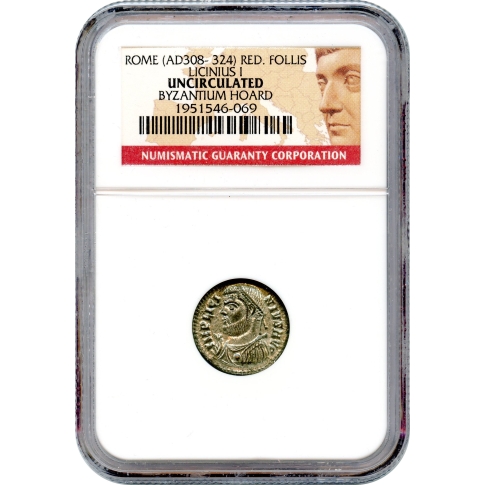Ancient Rome - AD 308-324 Licinius, Reduced Follis NGC UNC Ex.Byzantium Hoard
Licinius I (Gaius Velerius Licinianus Licinius), c. A.D. 250 or c. 263/5-325, was Augustus from A.D. 308-324. Born of peasant stock in Dacia Ripensis (Upper Moesia), Lucinius I was an army officer who served with distinction in Galerius's war against the Sasanians in 297-298. He was adopted by Diocletian. His loyalty and abilities proven time and time again, Licinius was raised to Junior Augustus in 308. From his headquarters in Pannonia, he took a defensive position against his rivals: Maxentius in Italy, Alexander in Carthage, Maximinus II Daia in Asia, and Constantine I in Gaul. After Galerius died in 311, Licinius and Maximinus II Daia divided up his former territories, with Licinius settling for the smaller European region. The two declared a truce, which in reality was a cold peace. Licinius treated with Constantine I in 312, resulting in Maximinus II Daia forming an alliance with Maxentius. Constantine invaded Italy, deposing Maxentius. Then Licinius and Constantine together issued the Edict of Milan, establishing religious tolerance in the Empire. Maximinus Daia was concerned about their treaty, and invaded Thrace in the Balkans. The armies of Licinius and Maximinus Daia clashed in 313, where Daia's much larger force was soundly defeated. Daia fled back to Asia, dying later in Tarsus. Licinius executed man of Daia's supporters and took control of all of Asia and Egypt. The alliance formed by Licinius and Constantine was merely one of convenience, and it was a matter of time before they came into direct conflict. The next 11 years saw the two rival emperors bring their children into the Imperial world and fight two costly civil wars. In order to avoid conflict, the two rivals established a "buffer state" between them, in Rhaetia and Pannonia, led by Bassianus. However, Licinius persuaded Bassianus to revolt on his behalf. This resulted in the First Lincinian War of 316, after which Lincinius lost ground to Constantine. Over the next several years the rival emperors barely tolerated each other, as hostilities continued to increase. Then in 322/3 Constantine entered Licinius's territory of Thrace, which, by 324, gave cause to the beginning of the Second Licinian War. Lincinius was cornered and terms of surrender were negotiated. However, he was eventually executed by Constantine in 325.
| Grading Service | NGC |
|---|---|
| Year of Issue | NONE |
| Grade | MS60 |
| Ancient Year Range | 301-400 AD |
| Denom Type | Ancient |
| Numeric Denomination | Reduced Follis |
| Mint Location | NONE |
| Designation | NONE |
| Circ/UnCirc | Uncirculated |
| Strike Type | Business |
| Grade Add On | NONE |
| Holder Type | N/A |



